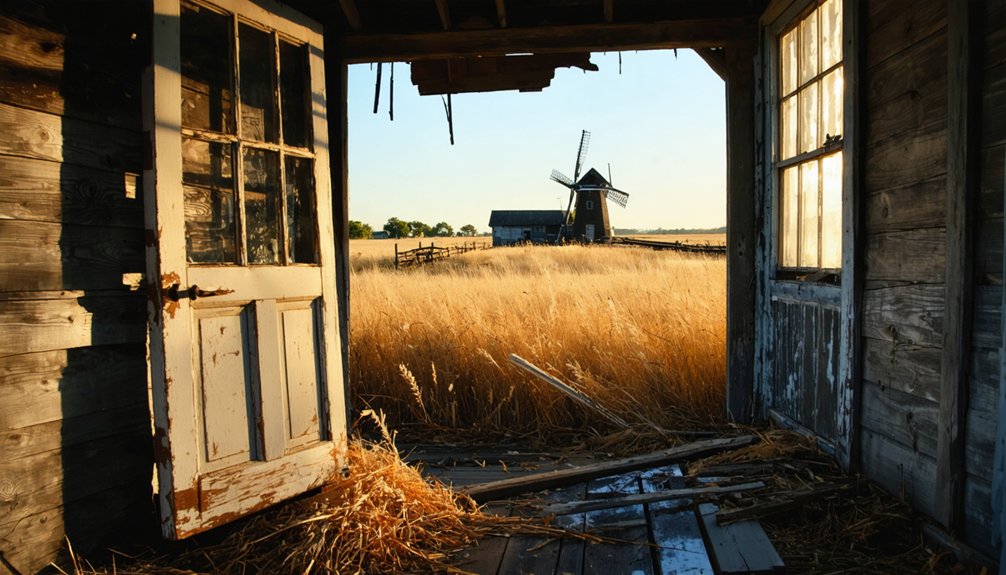Sampont emerged in the 1850s as a Black Hills settlement during South Dakota’s mining boom, founded through land treaties and government initiatives. You’ll find its history marked by European immigrant influences, particularly German and Scandinavian, who built a thriving dual economy based on agriculture and mining. The town declined sharply after the 1930s due to depleted mineral deposits, railway service withdrawal, and agricultural mechanization. By 1967, Sampont was completely abandoned, with only scattered foundations remaining beneath reclaimed prairie. The site’s remote location holds untold stories of frontier resilience and pioneer spirit.
Key Takeaways
- Sampont emerged in the 1850s as a mining and agricultural settlement, shaped by European immigrants, particularly Germans and Scandinavians.
- The town’s economy relied heavily on mining operations and grain elevators, supported by crucial railway connections for transportation.
- Economic decline began with dwindling mineral deposits and railway service withdrawal, leading to the closure of mining operations by 1940s.
- The town was completely abandoned by 1967, with all original structures demolished and the site now reclaimed by natural pasture.
- Visitors need rugged vehicles and thorough preparation to access this remote location, with only scattered foundations remaining as evidence.
The Birth of a Prairie Settlement
While the settlement of eastern South Dakota emerged through a complex series of land treaties and government initiatives in the 1850s, the foundations for prairie communities took shape through deliberate federal policies and commercial interests.
You’ll find that settlement patterns typically followed military outposts and railway lines, as these provided essential security and transportation links for new arrivals. The cultural influences of European immigrants, particularly Germans and Scandinavians, helped establish viable farming communities across the territory. The Treaty of Traverse in 1851 opened vast new territories for settlement by arranging land purchases from the Sioux.
Land companies from Iowa and Minnesota competed to establish towns near rivers, understanding that water access was vital for community survival. The Homestead Act of 1862 accelerated this development by offering 160-acre parcels to settlers willing to cultivate the prairie, transforming the landscape into an agricultural frontier. By 1860, the territory had grown to include approximately 5,000 permanent settlers, marking the beginning of substantial population growth in the region.
Life in Early Sampont
When settlers first established Sampont in the late 1800s, they faced the typical challenges of prairie life while building a close-knit agricultural community.
You’d have found families living in modest wooden or sod houses, working together to construct essential buildings like schools, churches, and communal barns. Community gatherings, from barn raisings to church services, strengthened social bonds and helped residents endure harsh conditions.
Life followed traditional roles, with men tending to farming and trades while women managed households. The area had been inhabited by Paleo-Indian hunters thousands of years before European settlement. The region saw rapid growth as rail lines reached the Missouri River, connecting isolated communities.
You’d have seen abundant vegetable gardens, preserved foods for winter, and shared resources during tough times. Most travel occurred by horse and wagon on dirt roads, while communication relied on postal routes.
The local church served as both a spiritual center and social hub, preserving cultural traditions through music, festivals, and shared customs.
Economic Foundations and Railway Connections
You’ll find that Sampont’s economic importance hinged on its railway connections, which served as essential supply lines for agricultural products and mining materials flowing between regional markets.
The town’s strategic position as a transportation hub attracted merchants, grain traders, and various business ventures that relied on rail shipping to move goods efficiently. Similar to how local speculators invested heavily in anticipating railroad routes, Sampont’s businesses particularly benefited from the extensive freight revenue that agriculture and mining together generated, accounting for nearly 45% of Great Northern Railway’s income by 1950.
As automobiles and trucks gained prominence after World War II, Sampont’s railway-dependent economy couldn’t adapt to changing transportation patterns, leading to the town’s swift decline.
Railway’s Essential Supply Role
The railway system served as the economic lifeline for Sampont and surrounding South Dakota communities during the town’s prime years. You’d find the rail lines delivering essential supplies that sustained the town’s growth – from construction materials and farming equipment to consumer goods and fuel.
The sophisticated railway logistics enabled reliable supply chains that connected Sampont to regional distribution networks.
You could see how the railway’s supply role transformed local commerce. The train depot became a crucial hub where you’d find regular shipments of mail, telegrams, and general merchandise.
Along the tracks, grain elevators and warehouses sprung up, creating efficient storage and shipping infrastructure. This railway supply network proved imperative in establishing Sampont’s economic viability and connecting local producers to broader markets.
Agriculture and Mining Links
Mining and agriculture formed interwoven economic pillars that sustained Sampont’s development throughout its prime years.
You’ll find evidence of this dual economy in the remaining structures, where grain depots and mining facilities once operated side by side. Local farmers supplied food to mining camps, while seasonal mining work provided additional income for agricultural families. Like many settlements formed by land company railroads, Sampont emerged as a strategic point for both industries. Similar to Cottonwood’s history, the town relied heavily on its grain elevator operations.
The town’s sustained agriculture helped buffer the boom-bust cycles of its mining heritage, though neither industry could ultimately prevent Sampont’s decline.
When rail service diminished, both sectors suffered greatly. The grain elevators and processing facilities that once served both mining and farming communities now stand as silent reminders of this economic partnership.
General stores and banks that supported both industries have largely disappeared, marking the end of this interconnected economic era.
Transportation Hub’s Quick Decline
While many frontier towns emerged organically, Sampont’s rise as a transportation hub stemmed directly from strategic railroad planning in Dakota Territory. The town’s hub significance centered on its railway depot, which served as a crucial nexus for telegrams, freight shipments, and passenger traffic connecting South Dakota communities to larger markets.
You’ll find that Sampont’s transportation evolution mirrors the broader shifts in America’s mobility patterns. After World War II, the rise of automobiles and trucking severely diminished railroad dominance.
As state and federal priorities shifted toward highway infrastructure, many short-line railroads serving towns like Sampont faced abandonment. The town’s economic foundation, built on rail-dependent industries and its role as a regional supply chain node, crumbled when railway companies withdrew their services due to declining revenue and unsustainable maintenance costs.
The Town’s Gradual Decline

When Sampont’s mineral deposits began dwindling in the mid-20th century, you’d have witnessed the rapid unraveling of the town’s economic foundation.
Mining operations, which had sustained the local workforce and commerce, scaled back considerably until their eventual closure. Like old mining town Tinton, operations ground to a halt despite once being a thriving mining community. The situation mirrored what happened in towns like Rockerville and Mystic, where decreased economic activity led to abandonment.
You’d then see the town’s population plummet as workers and their families sought opportunities elsewhere, leaving behind aging residents and deteriorating infrastructure.
Economic Activity Fades Away
As the mid-twentieth century approached, Sampont’s economic foundation began crumbling through a series of devastating blows to its core industries.
Despite attempts at economic resilience, you’d find the town’s commercial significance diminishing as these critical developments unfolded:
- The 1952 closure of the sawmill eliminated the town’s primary employer.
- Mining operations in the nearby Black Hills had largely exhausted their ore deposits by the 1940s.
- Railroad companies abandoned or rerouted lines away from Sampont, severing crucial transport links.
- Agricultural mechanization reduced labor needs while market access dwindled.
Community adaptation proved challenging as banks, general stores, and essential services shuttered their doors.
The loss of infrastructure investment and removal of railroad connections further isolated Sampont from regional commerce, accelerating its transformation into a ghost town.
Population Exodus Accelerates
Through a combination of economic hardships and regional migration patterns, Sampont’s population entered a steep downward spiral starting in the 1930s.
You’d have witnessed the town’s decline accelerate during the Dust Bowl era when South Dakota lost over 7% of its residents, with rural areas like Sampont hit particularly hard.
The exodus continued through the mid-century as agricultural mechanization reduced labor needs.
You’ll find that Sampont’s story mirrors many rural communities in South Dakota, where population migration led to dramatic losses of 60-70% from peak numbers.
By the 1960s, the town’s remaining residents joined the broader rural-to-urban shift, seeking opportunities elsewhere.
Despite efforts to retain inhabitants, Sampont couldn’t overcome the persistent challenges of rural depopulation, aging demographics, and diminishing services that ultimately sealed its fate as a ghost town.
Remnants and Ruins Today
Unlike many preserved ghost towns across South Dakota, Sampont exists today primarily as a barren site with minimal physical evidence of its past.
The urban decay has been so complete that by 1967, all original structures were demolished, leaving only scattered foundations and rubble across overgrown fields.
Archaeological findings at the site remain largely unexplored, with four key characteristics defining today’s landscape:
- No intact buildings or roofed structures survive
- Natural pasture has reclaimed most of the former town layout
- Absence of tourist infrastructure or interpretive signage
- Limited subsurface artifacts remain undocumented
You’ll find no standing post office, railroad structures, or prominent buildings that often mark other South Dakota ghost towns.
Without historical maps or local knowledge, identifying specific town features proves challenging in this remote location.
Historical Significance in South Dakota

While Sampont’s physical remnants have largely vanished, its historical footprint remains deeply embedded in South Dakota’s mining heritage. As one of the Black Hills’ ghost towns, Sampont exemplifies the region’s dynamic mining culture that shaped Western expansion during the late 19th and early 20th centuries.
You’ll find Sampont’s legacy woven into the broader narrative of South Dakota’s development, where mining communities served as crucial economic and social hubs. The town’s story mirrors the classic boom-bust cycle common to extractive economies, contributing to our understanding of frontier life.
Its history encompasses the immigrant experience, labor movements, and the challenges faced by early settlers. Today, Sampont stands as a reflection of the resilient spirit of pioneer communities and continues to attract those interested in preserving South Dakota’s rich mining heritage.
Visiting and Exploring Sampont
Before commencing a journey to Sampont, visitors should understand the site’s remote nature and limited accessibility. Ghost town exploration requires thorough preparation, as you’ll encounter minimal infrastructure and potentially poor cell coverage.
You’ll need a rugged vehicle to navigate dirt roads leading to this lesser-known destination.
For safe and rewarding visitor safety during your expedition, follow these essential steps:
- Pack sufficient water, food, and emergency supplies
- Inform others of your travel plans before departing
- Bring navigation tools and historical documentation
- Prepare for variable weather conditions
While exploring Sampont’s remaining structures and historical features, you’ll find opportunities for photography and historical interpretation.
Remember to respect any private property boundaries and exercise caution around deteriorating buildings. The site serves as an open-air museum of South Dakota’s settlement history.
Frequently Asked Questions
Were There Any Notable Crimes or Lawlessness Reported in Sampont’s History?
You won’t find verified crime incidents or formal law enforcement records from Sampont’s past, though nearby mining towns experienced typical frontier disorder – suggesting similar but undocumented challenges likely occurred there.
Did Any Famous Personalities or Historical Figures Ever Visit Sampont?
You won’t find records of any famous visitors or historical connections to Sampont. Unlike better-documented Black Hills towns that attracted notable figures, this small mining community lacks evidence of distinguished guests.
What Native American Tribes Originally Inhabited the Area Around Sampont?
Like buffalo roaming the endless plains, the Sioux Tribes dominated this region, with Lakota Culture particularly strong in the area. You’ll find Western Dakota bands were also present historically.
Were There Any Major Natural Disasters That Affected Sampont?
While you’ll find no records of major flood impacts or fire devastation specifically in Sampont, the town likely endured typical regional hardships like harsh winters and seasonal flooding common to South Dakota settlements.
Did Sampont Have Its Own Newspaper or Local Publications?
You won’t find evidence of local journalism specific to Sampont. Residents likely relied on historical publications from nearby towns like Mitchell, Philip, and Mobridge for their regional news coverage.
References
- https://www.sdpb.org/arts-life/vanished-south-dakota-in-the-moment
- https://www.youtube.com/watch?v=Glucs_Rq8Xs
- https://www.youtube.com/watch?v=_0WNYsFLSLA
- https://www.powderhouselodge.com/black-hills-attractions/fun-attractions/ghost-towns-of-western-south-dakota/
- https://www.southdakotamagazine.com/galenas-ghosts
- https://www.blackhillsbadlands.com/blog/post/old-west-legends-mines-ghost-towns-route-reimagined/
- https://icatchshadows.com/okaton-and-cottonwood-a-photographic-visit-to-two-south-dakota-ghost-towns/
- https://en.wikipedia.org/wiki/List_of_ghost_towns_in_South_Dakota
- https://aberdeenmag.com/2019/01/the-ghost-towns-of-brown-county/
- https://b1027.com/south-dakota-has-an-abundance-of-ghost-towns/



